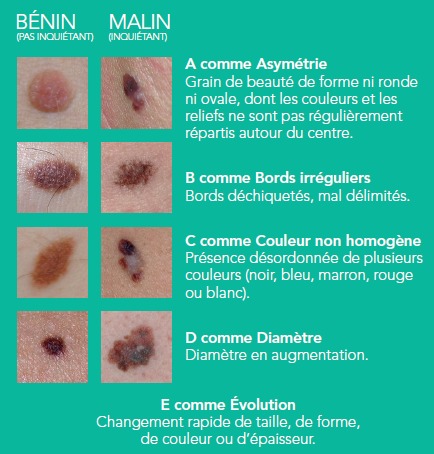
The prevalence of skin cancer has more than tripled over the last thirty years in Europe, reaching today more than 140,000 cases diagnosed each year. They are among the most common in Europe. In the vast majority of cases attributable to excessive exposure to ultraviolet rays, these cancers could therefore be easily avoided. What are the different types of skin cancers? Which is the most dangerous? How to recognize the symptoms? The answers of Dr Jean Ménard, radiotherapist oncologist in Paris.
What are the different types of skin cancers?
There are several forms of skin cancer, classified according to the skin cells from which they develop. Three of them are the most common:
- Basal cell carcinoma, which develops from the basal cells of the upper layer of the skin – namely the epidermis – is by far the most common. It represents approximately 70% of skin cancers. This type of cancer is generally slow to spread and has low metastatic potential, but it can cause local damage if left untreated;
- Squamous cell carcinoma, which represents 20% of skin cancers, and develops from squamous cells of the epidermis. It can spread more quickly than basal cell carcinoma and has a slightly higher risk of metastasis.
- Melanoma, which represents a tenth of skin cancers, but which is also the most fatal. It develops from melanocytes, the cells responsible for producing melanin, which gives the skin its color. Melanoma can spread quickly and spread to other parts of the body;
What is the most dangerous skin cancer?
Among the three most common forms of skin cancer, melanoma is undeniably the most dangerous. “Melanoma is the most aggressive, due to its rapid growth and high risk of potentially fatal metastatic progression.” says Dr. Ménard. Furthermore, melanomas can develop from existing birthmarks or new lesions on the skin, and can have a variety of shapes, colors and sizes, which can complicate their early identification .
And that’s where the downside hurts, because when it’s not detected and treated quickly, melanoma can become fatal. Metastatic melanomas, in particular, have a poor prognosis and can be difficult to treat. Cutaneous melanoma ranks 8th among cancers in men and 6th among women.
Location: hand, nose, face, scalp
Although these different carcinomas can develop anywhere on the body, photo-exposed areas, namely the arms, face, back, lower legs and scalp are more at risk. Basal cell carcinoma is most often located in the head and neck.
In some cases, all three forms of cancer can appear on the mucous membranes of the mouth, nose or genitals. And melanoma, for its part, can even appear on the eye, we then speak of ocular melanoma.
Risk factor: what are the links between the sun and skin cancer?
It’s no secret that the sun’s radiation is the main risk factor for skin cancer, since more than 85% of them are the consequence of excessive exposure to ultraviolet light. Exposure to the sun has been classified as a group 1 carcinogen for humans by the IARC since 1992. When they reach the skin, excessive doses of UV damage the skin cells and can even cause irreversible damage to the genes of the exposed cells. .
The three most common types of skin cancer are linked to exposure to UV radiation.
- Skin carcinomas whether they are basal cell or squamous cell, they are most often linked to chronic solar exposure over the course of life;
- Cutaneous melanomas : these malignant tumors most often resemble moles but with abnormal shapes or colors, and can quickly metastasize. Two thirds of these cancers are linked to excessive exposure to the sun, mainly intermittent and intense exposure during childhood.
Cutaneous melanoma, the most aggressive form, represents between 2 and 3% of all cancers, which places it 9th among the most common cancers in Europe.
Red spot, irregular mole, pimple: What are the first signs and symptoms of skin cancer?
At its earliest stage, skin cancer is usually asymptomatic. The first signs of skin cancer can vary greatly, depending on the type of skin cancer and the area of the body affected. They may appear in the form of a wound that does not heal or reappears, red patches on rough and/or scaly skin, a brown or pink spot, skin that oozes, bleeds or crusts over a wound or a mole, depigmented areas reminiscent of a scar or even a mass on the skin…”Overall, cancer should be suspected in any abnormality that appears on the skin, particularly in the event of asymmetry or change in color. In any case, the evolving nature must lead to systematic consultation“insists Dr. Ménard.
To monitor that a mole is not cancerous, health professionals have developed a simple method, based on alert criteria called ABCDE.
- A: Asymmetry : a mole that is not round and symmetrical must attract attention,
- B: Irregular edges. The edges of a mole should ideally have a regular outline and well-defined edges.
- C: Color of the mole, which must be uniform. If a mole contains several shades of brown, this is a warning sign.
- D: Diameter of the nevus. Above 5 to 6 mm, they must be monitored more carefully.
- E : Evolution. A mole that appears suddenly, grows or changes color requires increased monitoring.

What screening for skin cancer?
In Europe, there is no systematic skin cancer screening program financed by Social Security. “Screening is therefore individual, and consists of regular dermatological monitoring, particularly when you already have multiple moles or have a family history.” emphasizes the oncologist. Skin cancer screenings are carried out during routine medical visits or during consultations for suspicious skin lesions. The dermatologist then carries out a visual examination of the skin to look for signs of cancer and may recommend, if necessary, additional examinations, such as dermatoscopy or skin biopsy.
Despite the absence of a systematic screening program, it is strongly recommended to regularly monitor your skin according to the ABCDE criteria, and to consult a health professional in the event of suspicious changes. Awareness and education campaigns on skin self-examination are often conducted to encourage individuals to be aware of the signs of skin cancer and seek early detection.
Diagnosis: How do you know if you have skin cancer?
“If the lesion seems suspicious, the diagnosis is always based on pathological evidence obtained by skin biopsy which can be done in the office.” indicates Dr. Ménard. The biopsy is generally done using a small needle or biopsy instrument which takes a small piece of the lesion. Before this, local anesthesia may be offered, to numb the area and minimize any pain or discomfort during the procedure.
Once the tissue sample is collected, it is placed in a specific container and sent to a pathology laboratory for analysis. The structure of the cells, their appearance and their behavior will be examined to determine the possible presence of cancer cells. A biopsy report will provide information about the type of skin cancer, its stage, and other important characteristics to guide treatment.
Skin Cancer Treatment
Treatment for skin cancer depends on the type of cancer, its size, location, and stage. But surgery is the main treatment for skin cancer.
Treatment of basal cell carcinoma (namely the most common skin cancer) is essentially surgical because this cancer has a purely local evolution. In some cases of superficial basal cell carcinoma, creams or lotions containing chemotherapy drugs to apply directly to the skin may be offered.
“First-line treatment for melanoma localized is surgical. For metastatic melanomas, treatment may be chemotherapy, immunotherapy or targeted therapy. Targeted therapies are drugs that act specifically on cancer cells by targeting specific genetic abnormalities or signaling pathways. Immunotherapy involves the use of drugs that stimulate the immune system to fight cancer. This treatment is booming and tends to develop more and more in this type of cancer.” specifies Dr. Ménard.
Treatment of squamous cell carcinoma is also essentially surgical in localized forms. Depending on certain aggressive factors, post-surgery radiotherapy may be offered. Likewise, when surgery is impossible, radiotherapy may be considered.
But the best way to protect yourself from skin cancer remains avoidance of risk factorshas…
